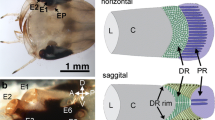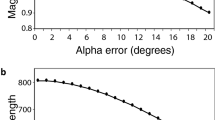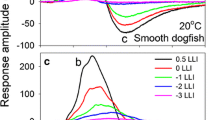Abstract
The accuracy of toad snapping towards moving worm dummies under various levels of dim illumination (from absolute threshold to “moonlight”) was videorecorded and related to spike responses of retinal ganglion cells exposed to equivalent stimuli. Some toads (at ca. 16 °C) successfully snapped at dummies that produced only one photoisomerization per 50 rods per second in the retina, in good agreement with thresholds of sensitive retinal ganglion cells. One factor underlying such high sensitivity is extensive temporal summation by the ganglion cells. This, however, is inevitably accompanied by very long response latencies (around 3 s near threshold), whereby the information reaching the brain shows the dummy in a position where it was several seconds earlier. Indeed, as the light was dimmed, snaps were displaced successively further to the rear of the dummy, finally missing it. The results in weak but clearly supra-threshold illumination indicate that snaps were aimed at the advancing head as seen by the brain, but landed further backwards in proportion to the retinal latency. Near absolute threshold, however, accuracy was “too good”, suggesting that the animal had recourse to a neural representation of the regularly moving dummies to correct for the slowness of vision.
Similar content being viewed by others

References
Aho A-C, Donner K, Hydén C, Reuter T, Orlov O Y (1987) Retinal noise, the performance of retinal ganglion cells, and visual sensitivity in the dark-adapted frog. J Opt Soc Am A 4:2321–2329
Aho A-C, Donner K, Hydén C, Larsen LO, Reuter T (1988) Low retinal noise in animals with low body temperature allows high visual sensitivity. Nature (Lond) 334:348–350
Aho A-C, Donner K, Reuter T (1993) Retinal origins of the temperature effect on absolute visual sensitivity in frogs. J Physiol (Lond) 463:501–521
Bäckström A-C, Hemilä S, Reuter T (1978) Directional selectivity and colour coding in the frog retina. Med Biol 56:76–83
Baylor DA, Hodgkin AL, Lamb TD (1974) The electrical response of turtle cones to flashes and steps of light. J Physiol (Lond) 242:685–727
Baylor DA, Lamb TD, Yau K-W (1979) Rod responses to single photons. J Physiol (Lond) 288:613–634
Baylor DA, Matthews G, Yau K-W (1980) Two components of electrical dark noise in toad retinal rod outer segments. J Physiol (Lond) 309:591–621
Copenhagen DR, Donner K, Reuter T (1987) Ganglion cell performance at absolute threshold in toad retina: effects of dark events in rods. J Physiol (Lond) 393:667–680
Donner K (1981) Receptive fields of frog retinal ganglion cells: response formation and light-dark-adaptation. J Physiol (Lond) 319:131–142
Donner K (1987) Adaptation-related changes in the spatial and temporal summation of frog retinal ganglion cells. Acta Physiol Scand 131:479–487
Donner K (1989a) Visual latency and brightness: an interpretation based on the responses of rods and ganglion cells in the frog retina. Visual Neurosci 3:39–51
Donner K (1989b) The absolute sensitivity of vision: can a frog become a perfect detector of light-induced and dark rod events? Physica Scripta 39:133–140
Donner KO, Reuter T (1962) The spectral sensitivity and photopigment of the green rods in the frog's retina. Vision Res 2:357–372
Donner K, Copenhagen DR, Reuter T (1990) Weber and noise adaptation in the retina of the toad Bufo marinus. J Gen Physiol 95:733–753
du Pont JS, de Groot PJ (1974) A schematic dioptric apparatus for the frog's eye (Rana esculenta). Vision Res 16:803–810
Eikmanns K-H von (1955) Verhaltensphysiologische Untersuchungen über den Beutefang und das Bewegungssehen der Erdkröte (Bufo bufo L.). Z Tierpsychol 12:229–253
Ewert J-P (1967) Untersuchungen über die Anteile zentralnervöser Aktionen an der taxisspezifischen Ermüdung beim Beutefang der Erdkröte (Bufo bufo L.). Z Vergl Physiol 57:263–298
Ewert J-P, Hock F (1972) Movement-sensitive neurones in the toad's retina. Exp Brain Res 16:41–59
Ewert J-P, Borchers H-W, Wietersheim A v (1978) Question of prey capture detectors in the toad's Bufo bufo (L.) visual system: A correlation analysis. J Comp Physiol 126:43–47
Govardovskii VI, Zueva LV (1974) Spectral sensitivity of the frog eye in the ultraviolet and visible region. Vision Res 14:1317–1321
Grüsser O-J, Grüsser-Cornehls U (1968) Neurophysiologische Grundlagen visueller angeborener Auslösemechanismen beim Frosch. Z Vergl Physiol 59:1–24
Hemilä S, Reuter T (1981) Longitudinal spread of adaptation in the rods of the frog's retina. J Physiol (Lond) 310:501–528
Himstedt W (1982) Prey selection in salamanders. In: Ingle DJ, Goodale MA, Mansfield RJW (eds) The analysis of visual behaviour. The MIT Press, Cambridge, Mass, pp 47–66
Jagger WS (1988) Optical quality of the eye of the cane toad Bufo marinus. Vision Res 28:105–114
Lamb TD (1984) Effects of temperature changes on toad rod photocurrents. J Physiol (Lond) 346:557–578
Lamb TD, Pugh EN Jr (1992) G-protein cascades: gain and kinetics. Trends Neurosci 15:291–298
Larsen LO (1984) Feeding in adult toads: physiology, behaviour, ecology. Vidensk Meddr Dansk Naturh Foren 147:97–116
Larsen LO (1992) Feeding and digestion. In: Feder ME, Burggren WW (eds) Environmental physiology of the amphibians. The University of Chicago Press, Chicago, pp 378–394
Larsen LO, Pedersen JN (1982) The snapping response of the toad, Bufo bufo, towards prey dummies at very low light intensities. Amphibia-Reptilia 2:321–327
Lescure J (1965) L'alimentation et le comportement de prédation chez Bufo bufo (Linnaeus, 1758). Thès Fac Sci Univ Paris, Série 4:4657
Lescure J (1982) Le comportement alimentaire. In: Grassé PP (ed) Traité de Zoologie, Amphibiens 2:215–222
Lock A, Collett T (1979) A toad's devious approach to its prey: a study of some complex uses of depth vision. J Comp Physiol 131:179–189
Mansfield RJW, Daugman JG (1978) Retinal mechanisms of visual latency. Vision Res 18:1247–1260
Maturana HR, Lettvin JY, McCulloch WS, Pitts WH (1960) Anatomy and physiology of vision in the frog (Rana pipiens). J Gen Physiol 43:129–175
Putnam RW, Bennett AF (1981) Thermal dependence of behavioural performance of anuran amphibians. Anim Behav 29:502–509
Reuter T, Virtanen K (1976) Color discrimination mechanisms in the retina of the toad (Bufo bufo). J Comp Physiol 109:337–343
Schneider D (1954) Beitrag zu einer Analyse des Beuteund Fluchtverhaltens einheimischer Anuren. Biol Zbl 73:225–282
Author information
Authors and Affiliations
Rights and permissions
About this article
Cite this article
Aho, A.C., Donner, K., Helenius, S. et al. Visual performance of the toad (Bufo bufo) at low light levels: retinal ganglion cell responses and prey-catching accuracy. J Comp Physiol A 172, 671–682 (1993). https://doi.org/10.1007/BF00195393
Accepted:
Issue Date:
DOI: https://doi.org/10.1007/BF00195393



